DODGE SPRINTER 2004 1.G Owners Manual
Manufacturer: DODGE, Model Year: 2004, Model line: SPRINTER, Model: DODGE SPRINTER 2004 1.GPages: 272, PDF Size: 22.71 MB
Page 161 of 272
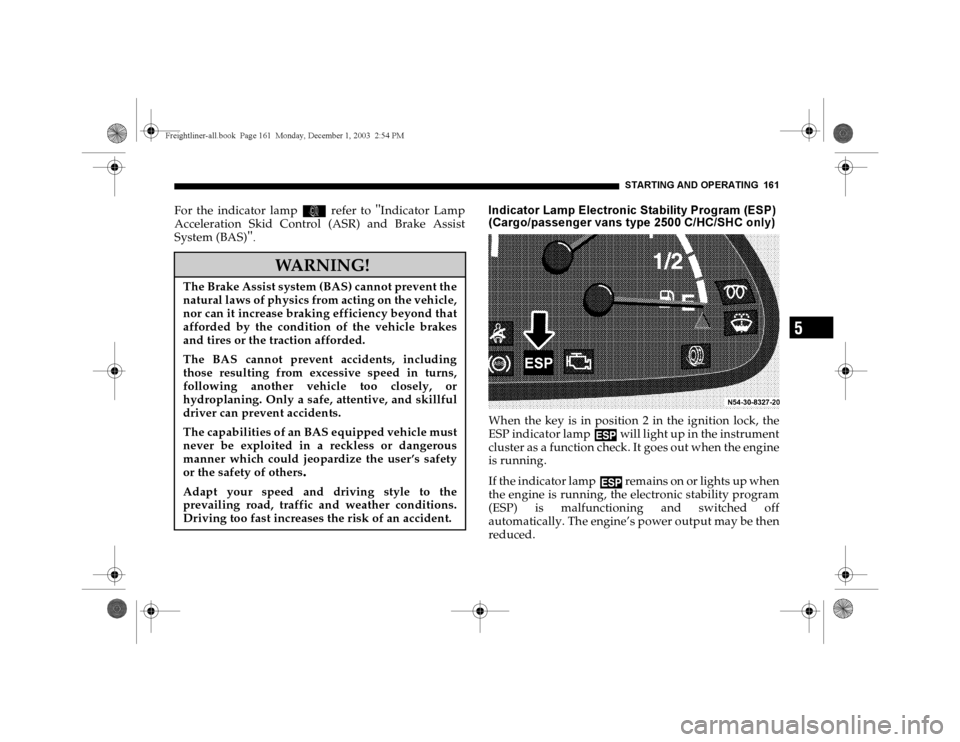
STARTING AND OPERATING 161
5
For the indicator lamp k refer to
"Indicator Lamp
Acceleration Skid Control (ASR) and Brake Assist
System (BAS)
".
Indicator Lamp Electronic Stability Program (ESP)
(Cargo/passenger vans type 2500 C/HC/SHC only)When the key is in position 2 in the ignition lock, the
ESP indicator lamp will light up in the instrument
cluster as a function check. It goes out when the engine
is running.
If the indicator lamp remains on or lights up when
the engine is running, the electronic stability program
(ESP) is malfunctioning and switched off
automatically. The engine’s power output may be then
reduced.
WARNING!
The Brake Assist system (BAS) cannot prevent the
natural laws of physics from acting on the vehicle,
nor can it increase braking efficiency beyond that
afforded by the condition of the vehicle brakes
and tires or the traction afforded.
The BAS cannot prevent accidents, including
those resulting from excessive speed in turns,
following another vehicle too closely, or
hydroplaning. Only a safe, attentive, and skillful
driver can prevent accidents.
The capabilities of an BAS equipped vehicle must
never be exploited in a reckless or dangerous
manner which could jeopardize the user’s safety
or the safety of others
.
Adapt your speed and driving style to the
prevailing road, traffic and weather conditions.
Driving too fast increases the risk of an accident.
Freightliner-all.book Pag e 161 Monday, December 1, 2003 2:54 PM
Page 162 of 272
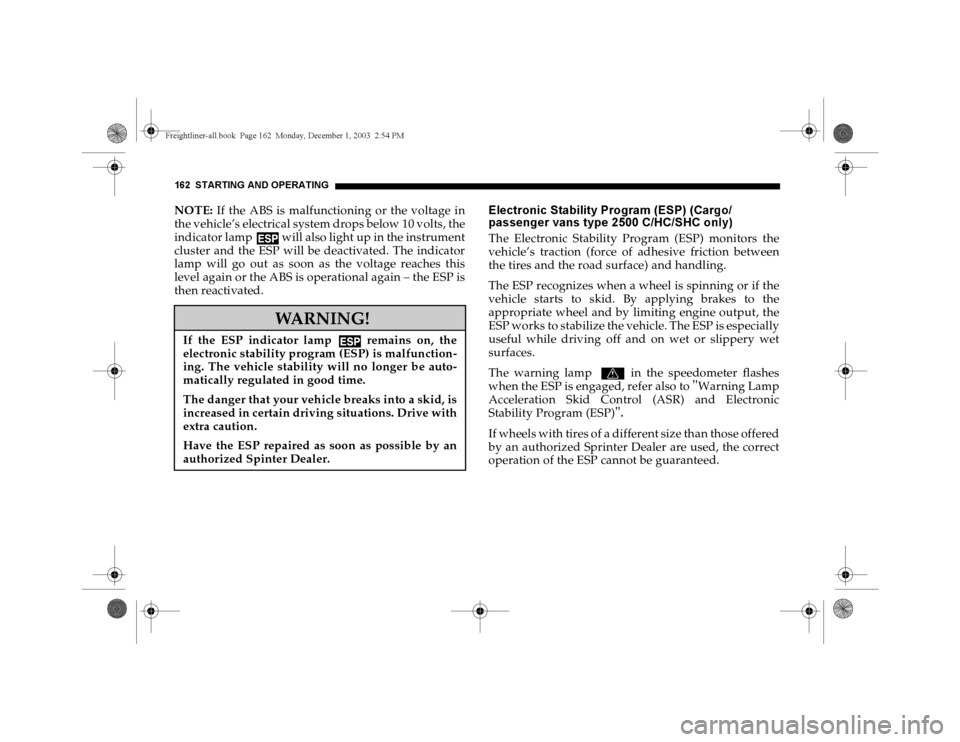
162 STARTING AND OPERATINGNOTE: If the ABS is malfunctioning or the voltage in
the vehicle’s electrical system drops below 10 volts, the
indicator lamp will also light up in the instrument
cluster and the ESP will be deactivated. The indicator
lamp will go out as soon as the voltage reaches this
level again or the ABS is operational again
– the ESP is
then reactivated.
Electronic Stability Program (ESP) (Cargo/
passenger vans type 2500 C/HC/SHC only)The Electronic Stability Program (ESP) monitors the
vehicle’s traction (force of adhesive friction between
the tires and the road surface) and handling.
The ESP recognizes when a wheel is spinning or if the
vehicle starts to skid. By applying brakes to the
appropriate wheel and by limiting engine output, the
ESP works to stabilize the vehicle. The ESP is especially
useful while driving off and on wet or slippery wet
surfaces.
The warning lamp v in the speedometer flashes
when the ESP is engaged, refer also to
"Warning Lamp
Acceleration Skid Control (ASR) and Electronic
Stability Program (ESP)
".
If wheels with tires of a different size than those offered
by an authorized Sprinter Dealer are used, the correct
operation of the ESP cannot be guaranteed.
WARNING!
If the ESP indicator lamp remains on, the
electronic stability program (ESP) is malfunction-
ing. The vehicle stability will no longer be auto-
matically regulated in good time.
The danger that your vehicle breaks into a skid, is
increased in certain driving situations. Drive with
extra caution.
Have the ESP repaired as soon as possible by an
authorized Spinter Dealer.
Freightliner-all.book Pag e 162 Monday, December 1, 2003 2:54 PM
Page 163 of 272
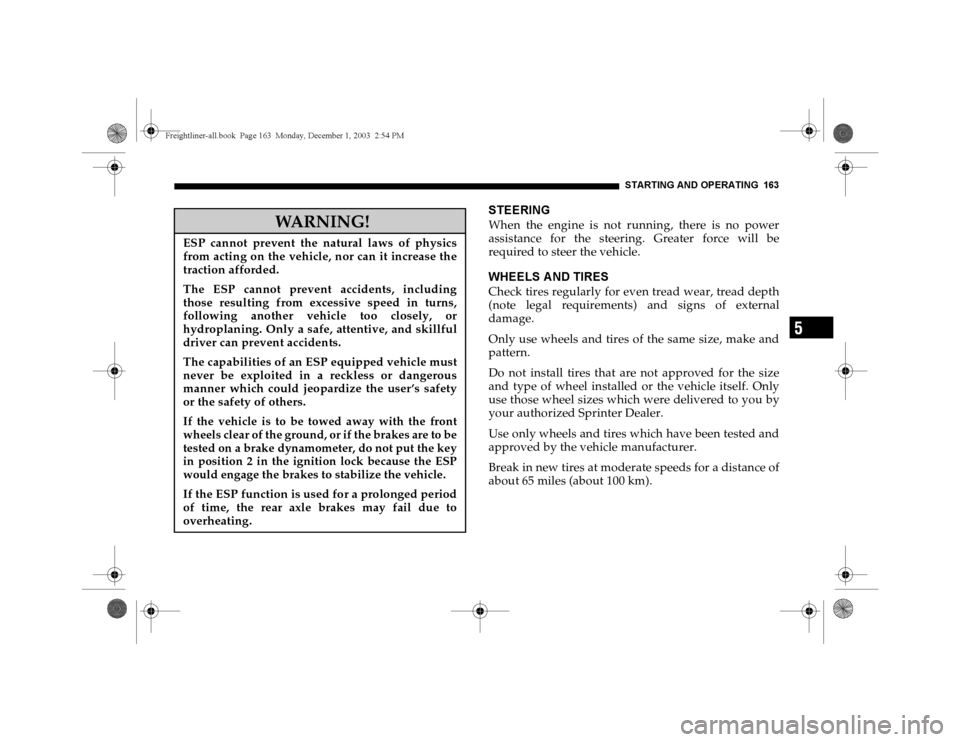
STARTING AND OPERATING 163
5
STEERINGWhen the engine is not running, there is no power
assistance for the steering. Greater force will be
required to steer the vehicle.WHEELS AND TIRESCheck tires regularly for even tread wear, tread depth
(note legal requirements) and signs of external
damage.
Only use wheels and tires of the same size, make and
pattern.
Do not install tires that are not approved for the size
and type of wheel installed or the vehicle itself. Only
use those wheel sizes which were delivered to you by
your authorized Sprinter Dealer.
Use only wheels and tires which have been tested and
approved by the vehicle manufacturer.
Break in new tires at moderate speeds for a distance of
about 65 miles (about 100 km).
WARNING!
ESP cannot prevent the natural laws of physics
from acting on the vehicle, nor can it increase the
traction afforded.
The ESP cannot prevent accidents, including
those resulting from excessive speed in turns,
following another vehicle too closely, or
hydroplaning. Only a safe, attentive, and skillful
driver can prevent accidents.
The capabilities of an ESP equipped vehicle must
never be exploited in a reckless or dangerous
manner which could jeopardize the user’s safety
or the safety of others.If the vehicle is to be towed away with the front
wheels clear of the ground, or if the brakes are to be
tested on a brake dynamometer, do not put the key
in position 2 in the ignition lock because the ESP
would engage the brakes to stabilize the vehicle.If the ESP function is used for a prolonged period
of time, the rear axle brakes may fail due to
overheating.
Freightliner-all.book Pag e 163 Monday, December 1, 2003 2:54 PM
Page 164 of 272
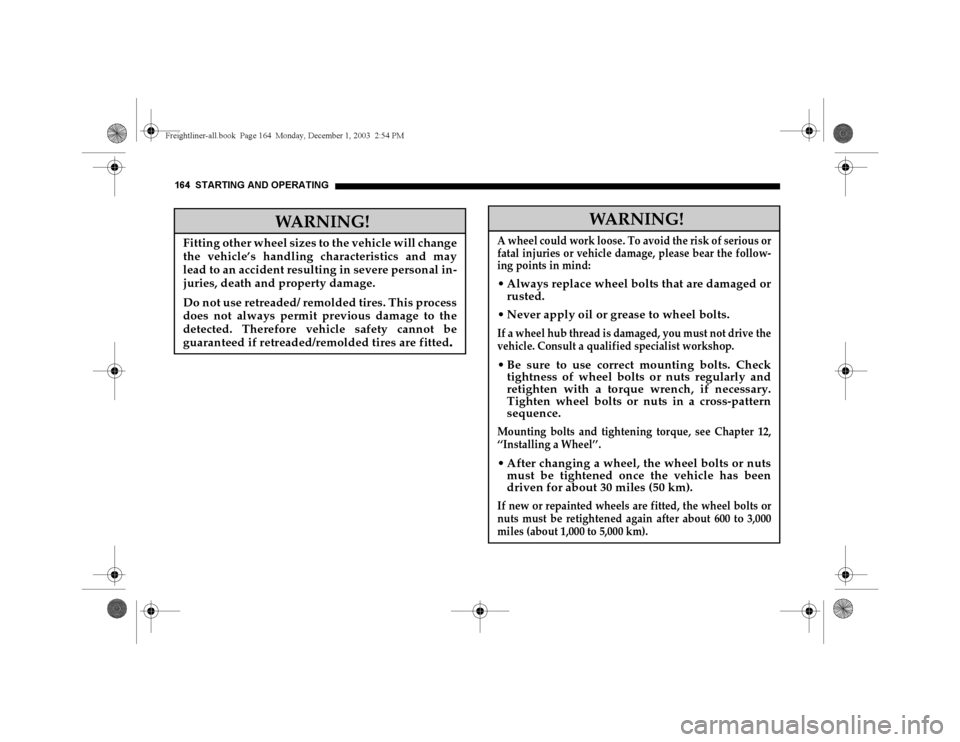
164 STARTING AND OPERATING
WARNING!
Fitting other wheel sizes to the vehicle will change
the vehicle’s handling characteristics and may
lead to an accident resulting in severe personal in-
juries, death and property damage.
Do not use retreaded/ remolded tires. This process
does not always permit previous damage to the
detected. Therefore vehicle safety cannot be
guaranteed if retreaded/remolded tires are fitted
.
WARNING!
A wheel could work loose. To avoid the risk of serious or
fatal injuries or vehicle damage, please bear the follow-
ing points in mind: Always replace wheel bolts that are damaged or
rusted.
Never apply oil or grease to wheel bolts. If a wheel hub thread is damaged, you must not drive the
vehicle. Consult a qualified specialist workshop. Be sure to use correct mounting bolts. Check
tightness of wheel bolts or nuts regularly and
retighten with a torque wrench, if necessary.
Tighten wheel bolts or nuts in a cross-pattern
sequence.Mounting bolts and tightening torque, see Chapter 12,
‘‘Installing a Wheel’’. After changing a wheel, the wheel bolts or nuts
must be tightened once the vehicle has been
driven for about 30 miles (50 km).If new or repainted wheels are fitted, the wheel bolts or
nuts must be retightened again after about 600 to 3,000
miles (about 1,000 to 5,000 km).
Freightliner-all.book Pag e 164 Monday, December 1, 2003 2:54 PM
Page 165 of 272
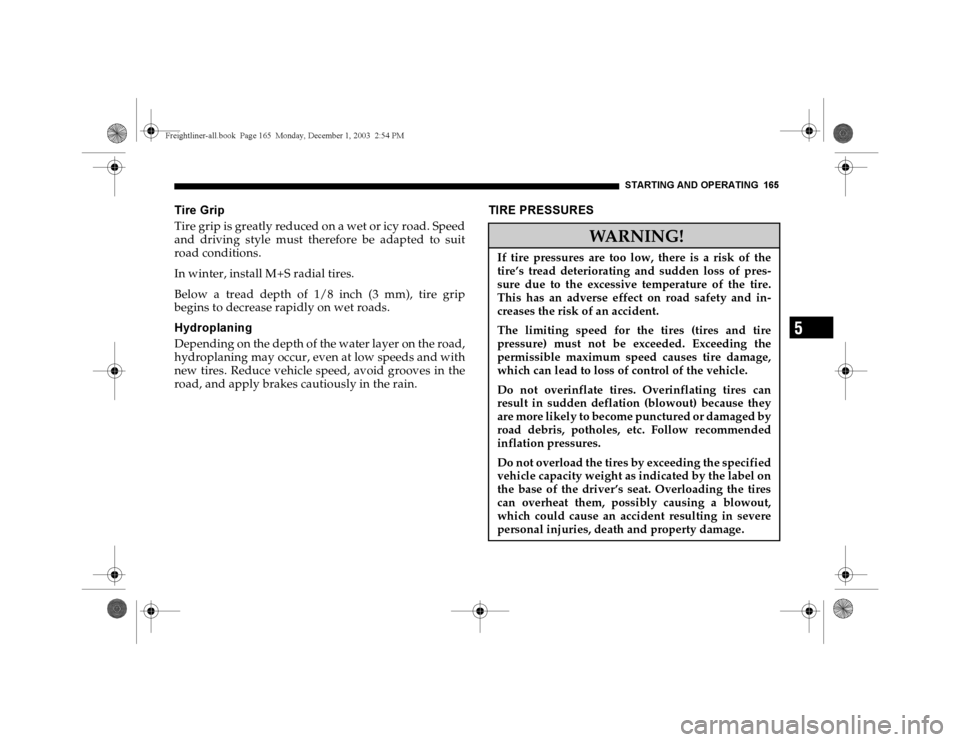
STARTING AND OPERATING 165
5
Tire GripTire grip is greatly reduced on a wet or icy road. Speed
and driving style must therefore be adapted to suit
road conditions.
In winter, install M+S radial tires.
Below a tread depth of 1/8 inch (3 mm), tire grip
begins to decrease rapidly on wet roads.HydroplaningDepending on the depth of the water layer on the road,
hydroplaning may occur, even at low speeds and with
new tires. Reduce vehicle speed, avoid grooves in the
road, and apply brakes cautiously in the rain.
TIRE PRESSURES
WARNING!
If tire pressures are too low, there is a risk of the
tire’s tread deteriorating and sudden loss of pres-
sure due to the excessive temperature of the tire.
This has an adverse effect on road safety and in-
creases the risk of an accident.
The limiting speed for the tires (tires and tire
pressure) must not be exceeded. Exceeding the
permissible maximum speed causes tire damage,
which can lead to loss of control of the vehicle.
Do not overinflate tires. Overinflating tires can
result in sudden deflation (blowout) because they
are more likely to become punctured or damaged by
road debris, potholes, etc. Follow recommended
inflation pressures.
Do not overload the tires by exceeding the specified
vehicle capacity weight as indicated by the label on
the base of the driver’s seat. Overloading the tires
can overheat them, possibly causing a blowout,
which could cause an accident resulting in severe
personal injuries, death and property damage.
Freightliner-all.book Pag e 165 Monday, December 1, 2003 2:54 PM
Page 166 of 272
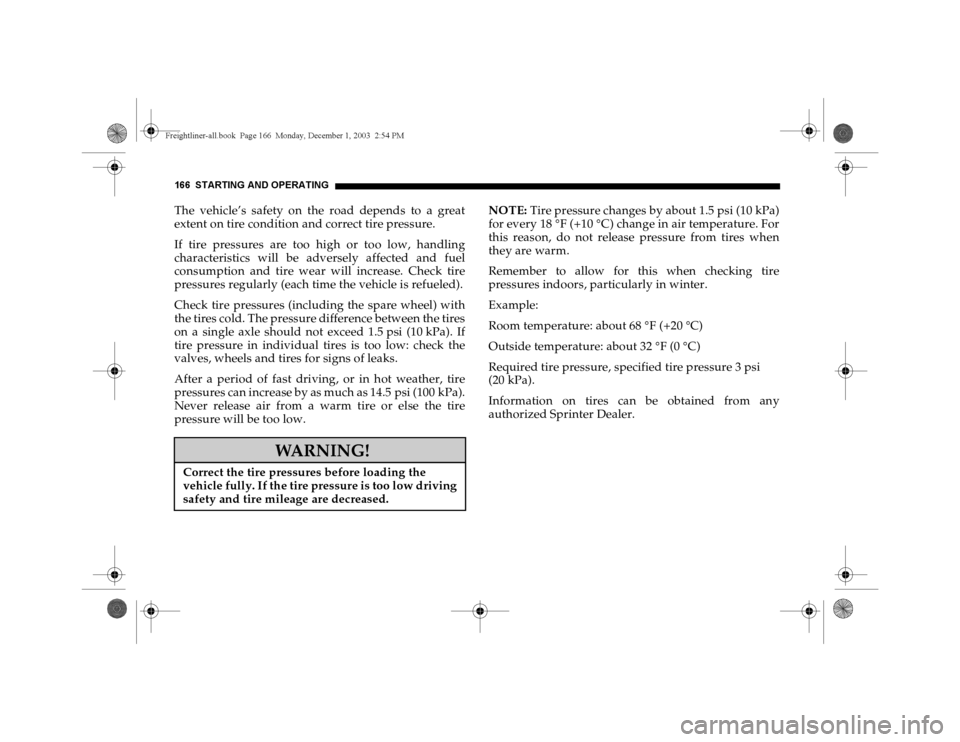
166 STARTING AND OPERATINGThe vehicle’s safety on the road depends to a great
extent on tire condition and correct tire pressure.
If tire pressures are too high or too low, handling
characteristics will be adversely affected and fuel
consumption and tire wear will increase. Check tire
pressures regularly (each time the vehicle is refueled).
Check tire pressures (including the spare wheel) with
the tires cold. The pressure difference between the tires
on a single axle should not exceed 1.5 psi (10 kPa). If
tire pressure in individual tires is too low: check the
valves, wheels and tires for signs of leaks.
After a period of fast driving, or in hot weather, tire
pressures can increase by as much as 14.5 psi (100 kPa).
Never release air from a warm tire or else the tire
pressure will be too low.NOTE: Tire pressure changes by about 1.5 psi (10 kPa)
for every 18
°F (+10
°C) change in air temperature. For
this reason, do not release pressure from tires when
they are warm.
Remember to allow for this when checking tire
pressures indoors, particularly in winter.
Example:
Room temperature: about 68
°F (+20
°C)
Outside temperature: about 32
°F (0
°C)
Required tire pressure, specified tire pressure 3 psi
(20 kPa).
Information on tires can be obtained from any
authorized Sprinter Dealer.
WARNING!
Correct the tire pressures before loading the
vehicle fully. If the tire pressure is too low driving
safety and tire mileage are decreased.
Freightliner-all.book Pag e 166 Monday, December 1, 2003 2:54 PM
Page 167 of 272

STARTING AND OPERATING 167
5
Tire Pressures of Loaded Vehicle in PSI (kPa)
Front Axle
Size ApplicationAxle loads in lbs (kg), see type plate
2,976
(1,350)3,219
(1,460)3,527
(1,600)3,638
(1,650)3,858
(1,750)
195/70 R 15 C 104 / 102 R Single 47 (325) 51 (350) – 58 (400) 65 (450)
225/70 R 15 C 112 / 110 R
(115 N)Single 36 (250) 36 (250) 40 (275) – 51 (350)
LT 225 / 75 R 16 115 N Single 55 (380)
Freightliner-all.book Pag e 167 Monday, December 1, 2003 2:54 PM
Page 168 of 272

168 STARTING AND OPERATINGTire Pressures of Loaded Vehicle in PSI (kPa)
Rear Axle
Size ApplicationAxle loads in lbs (kg), see type plate
5,070
(2,300)6,172
(2,800)6,613
(3,000)7,054
(3,200)
195/70 R 15 C 104 / 102 R Double 40 (275) 51 (350) 55 (380) 65 (450)Rear Axle
Size ApplicationAxle loads in lbs (kg), see type plate
3,307
(1,500)3,748
(1,700)3,968
(1,800)4,409
(2,000)4,938
(2,240)5,357
(2,430)
225/70 R 15 C 112 / 110 R
(115 N)Single 43 (300) 47 (325) 51 (350) 58 (400) 65 (450) 70 (480)
LT 225 / 75
R 16 115 NSingle 80 (550)
Freightliner-all.book Pag e 168 Monday, December 1, 2003 2:54 PM
Page 169 of 272
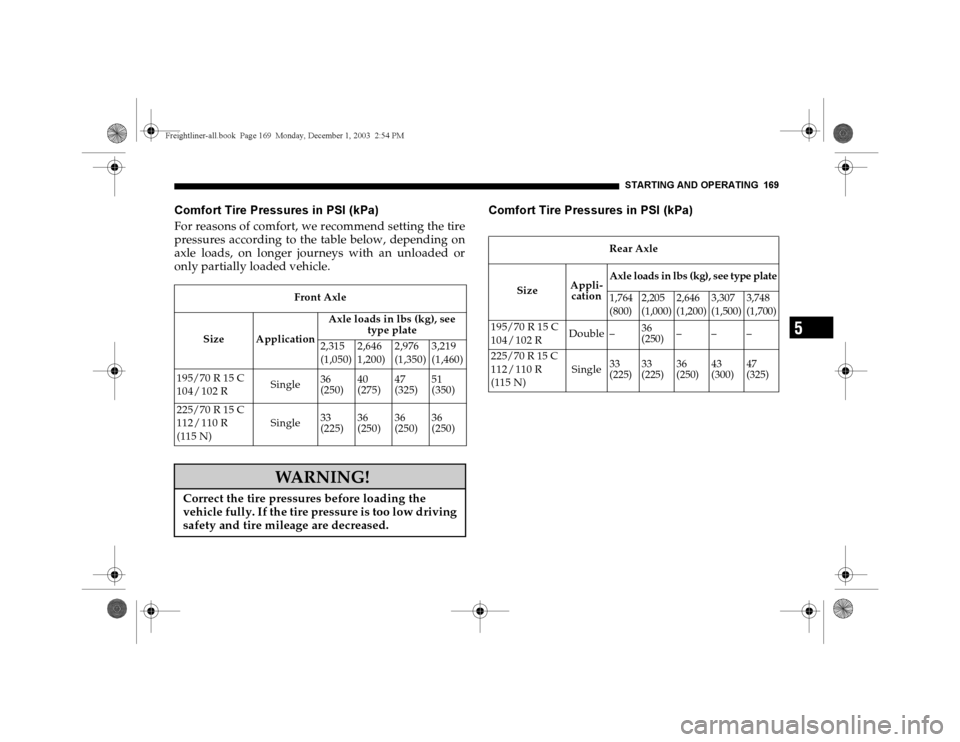
STARTING AND OPERATING 169
5
Comfort Tire Pressures in PSI (kPa)For reasons of comfort, we recommend setting the tire
pressures according to the table below, depending on
axle loads, on longer journeys with an unloaded or
only partially loaded vehicle.
Comfort Tire Pressures in PSI (kPa)
Front Axle
Size ApplicationAxle loads in lbs (kg), see
type plate
2,315
(1,050)2,646
1,200)2,976
(1,350)3,219
(1,460)
195/70 R 15 C
104 / 102 R Single36
(250)40
(275)47
(325)51
(350)
225/70 R 15 C
112 / 110 R
(115 N)Single33
(225)36
(250)36
(250)36
(250)
WARNING!
Correct the tire pressures before loading the
vehicle fully. If the tire pressure is too low driving
safety and tire mileage are decreased.
Rear Axle
SizeAppli-
cationAxle loads in lbs (kg), see type plate1,764
(800)2,205
(1,000)2,646
(1,200)3,307
(1,500)3,748
(1,700)
195/70 R 15 C
104 / 102 RDouble
–36
(250)–––
225/70 R 15 C
112 / 110 R
(115 N)Single
33
(225)33
(225)36
(250)43
(300)47
(325)
Freightliner-all.book Pag e 169 Monday, December 1, 2003 2:54 PM
Page 170 of 272
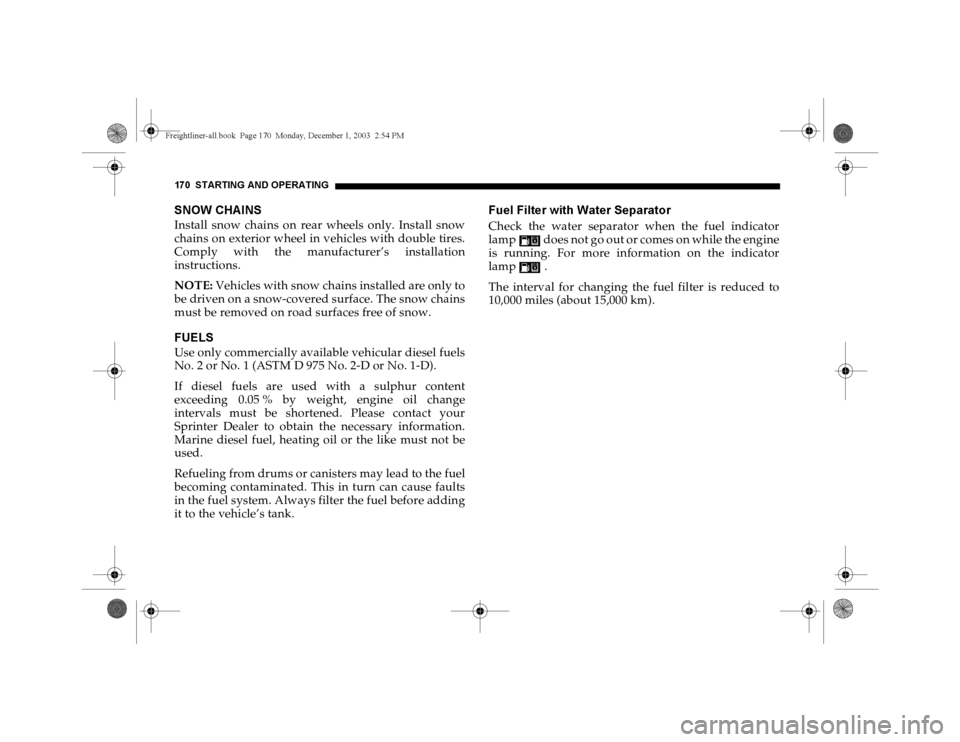
170 STARTING AND OPERATINGSNOW CHA INSInstall snow chains on rear wheels only. Install snow
chains on exterior wheel in vehicles with double tires.
Comply with the manufacturer’s installation
instructions.
NOTE: Vehicles with snow chains installed are only to
be driven on a snow-covered surface. The snow chains
must be removed on road surfaces free of snow.FUELSUse only commercially available vehicular diesel fuels
No. 2 or No. 1 (ASTM D 975 No. 2-D or No. 1-D).
If diesel fuels are used with a sulphur content
exceeding 0.05 % by weight, engine oil change
intervals must be shortened. Please contact your
Sprinter Dealer to obtain the necessary information.
Marine diesel fuel, heating oil or the like must not be
used.
Refueling from drums or canisters may lead to the fuel
becoming contaminated. This in turn can cause faults
in the fuel system. Always filter the fuel before adding
it to the vehicle’s tank.
Fuel Filter with Water SeparatorCheck the water separator when the fuel indicator
lamp does not go out or comes on while the engine
is running. For more information on the indicator
lamp .
The interval for changing the fuel filter is reduced to
10,000 miles (about 15,000 km).
Freightliner-all.book Pag e 170 Monday, December 1, 2003 2:54 PM